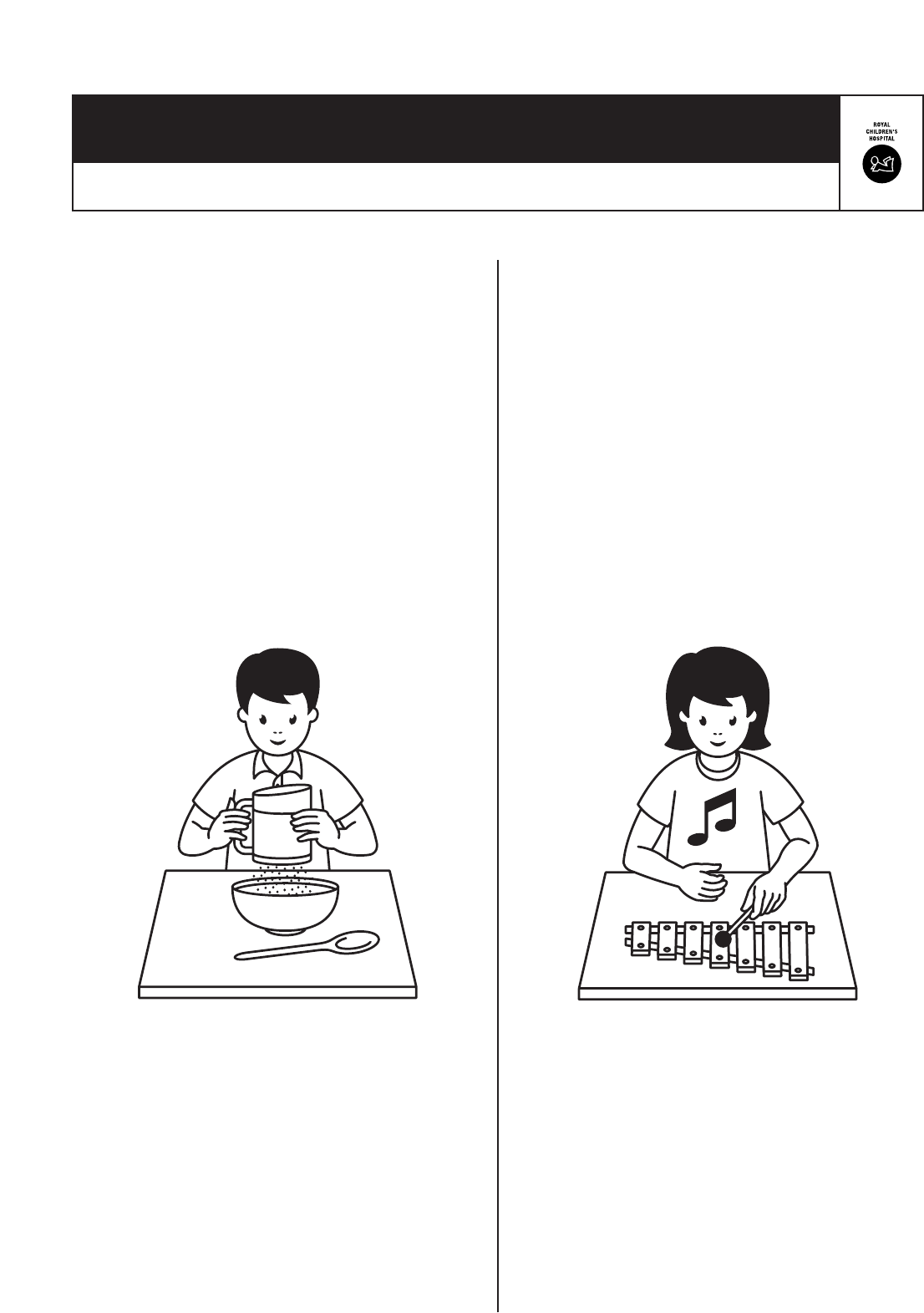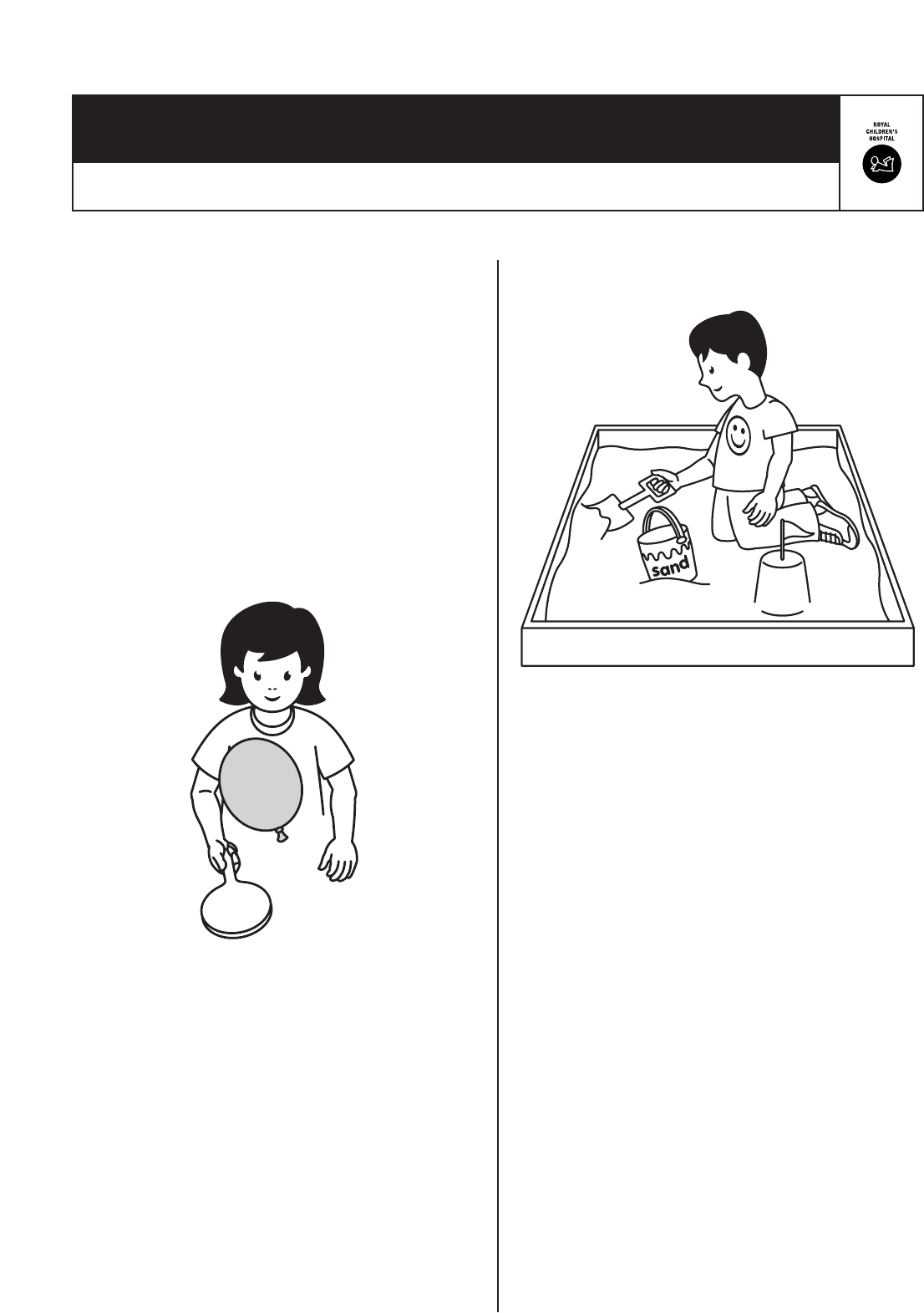
Definition
Hand preference refers to the consistent favouring of one
hand over the other for the skilled part of an activity. For
example, when writing or drawing the preferred hand
holds and uses the pencil whilst the other hand supports
the paper. Some people refer to the preferred hand as
the “dominant hand” or use the term “hand dominance”.
A hand preference usually starts to develop between the
ages of 2 to 4, however it is common at this stage for
children to swap hands. Between the ages of 4 to 6
years a clear hand preference is usually established.
Establishing which hand is the
preferred hand–helpful strategies
◗ If your child does not use one hand as his preferred
hand, do not choose or force him to use one hand.
Instead, carefully observe your child whilst he is
playing or doing everyday activities. Make a note
of whether one hand is used more, or if one hand
appears more skilled than the other. For example,
observe your child drawing or writing; cutting and
pasting; brushing his teeth or hair; eating and drinking;
and during any other play activities.
◗ Encourage your child to participate in a wide range of
play and everyday activities to provide opportunities
for your child to develop his hand skills.
◗ Position toys or activities in front, and to the centre,
of your child so that he can choose which hand to
use rather than using the hand closest to the toy.
For example, position pencils in front of your child
when he is drawing so that he can choose which hand
to hold the pencil with rather than using the hand
closest to the pencil.
© Department of Occupational Therapy, Royal Children’s Hospital, Melbourne 2005
ERC: 033256
Hand preference
Sheet B
Occupational Therapy – Kids health information

Encouraging the use of the
preferred hand–helpful strategies
◗ Once it is clear which hand your child prefers or
demonstrates more skill with, it is important to
encourage your child to consistently use this hand.
For example, when your child is cutting with scissors
encourage your child to use her preferred hand to
hold the scissors and her other hand to position
the paper.
◗ Talk to your child about using one hand as a
“doing” hand (preferred hand) and the other hand
as a “helping” hand.
◗ Give your child lots of feedback and encouragement
so she is aware of which hand she is using and can
start to more consistently use one hand as her
preferred hand.
◗ Encourage your child to finish an activity with the
hand she started with. If her hand becomes tired or
she wants to swap hands get her to stop and have
a rest (stretching and shaking arms/hands may be
helpful). Regular rest breaks may be required until
your child builds up the strength and skill to consistently
use her preferred hand.
Please talk to your occupational therapist if you have
any queries about the above information.
© Department of Occupational Therapy, Royal Children’s Hospital, Melbourne 2005 ERC: 033256

Fine-motor activities
Encourage your child to do these activities with his
preferred hand and use his other hand to hold and
position the paper, toy or object (if required).
◗ Drawing, colouring or writing.
◗ Cutting with scissors.
◗ Pasting with a glue stick or brush.
◗ Art and craft activities – ink stamps, stickers,
card making, mask making, stencils, tracing.
◗ Sharpening pencils.
◗ Building with blocks or lego.
◗ Playing board games and card games.
◗ Cooking activities – stirring, measuring, sifting.
◗ Playing musical instruments – recorder, violin,
keyboard, xylophone, trumpet, guitar.
◗ Computer games.
◗ Puzzles.
◗ Threading activities such as beads or lacing cards.
Please talk to your occupational therapist if you have
any queries about the above activity ideas.
© Department of Occupational Therapy, Royal Children’s Hospital, Melbourne 2005
ERC: 033256
Activity ideas for encouraging the use of the preferred hand
Sheet B1
Occupational Therapy – Kids health information

Everyday activities
Encourage your child to do these activities with her
preferred hand and use her other hand to hold and
position the object or toy (if required).
◗ Cleaning teeth with a toothbrush.
◗ Brushing hair with a hair brush.
◗ Holding sandwiches, biscuits, fruit or icy-poles.
◗ Using a fork and spoon when eating.
◗ Using a knife to cut up food or butter bread.
◗ Washing or drying the dishes.
◗ Bath-time activities – washing herself or a toy with
a face washer, pouring water into containers, winding
up bath toys.
◗ Opening drink bottles and lunch boxes.
◗ Removing lids from yoghurt containers, Vegemite
or jam jars.
◗ Zipping up school bags and clothing.
Please talk to your occupational therapist if you have
any queries about the above activity ideas.
© Department of Occupational Therapy, Royal Children’s Hospital, Melbourne 2005 ERC: 033256
Activity ideas for encouraging the use of the preferred hand
Sheet B2
Occupational Therapy – Kids health information

Gross-motor and outdoor activities
Encourage your child to do these activities with his
preferred hand and use his other hand to hold, position
or support the toy or object (if required).
◗ Sand pit activities – digging, pouring, driving cars
or trucks.
◗ Digging a small patch in the garden.
◗ Painting.
◗ Throwing balls or beanbags into a basket or at
a target.
◗ Playing skittles or bowls.
◗ Hitting a suspended ball or balloon with a bat.
◗ Tennis, cricket and other bat and ball games.
◗ Hammering with nails and wood.
◗ Winding the string when flying a kite.
◗ Washing the car.
Please talk to your occupational therapist if you have
any queries about the above activity ideas.
© Department of Occupational Therapy, Royal Children’s Hospital, Melbourne 2005 ERC: 033256
Activity ideas for encouraging the use of the preferred hand
Sheet B3
Occupational Therapy – Kids health information

Crossing the midline
Encourage your child to do these activities with her
preferred hand and make sure your child moves her hands
and arms across her body rather than changes hands.
◗ Position some beanbags or balls on your child’s
non-preferred side and ask her to pick them up
with her preferred hand and throw them into a
basket or at a target.
◗ Draw large drawings or designs on a blackboard
or a large piece of paper.
◗ Clean the kitchen table or bench.
◗ Make patterns using finger-paint or shaving cream,
going from left to right.
◗ Play “patience” with cards lined up from left side
to the right side.
◗ Encourage your child to pick up puzzle pieces placed
on her non-preferred side and put them in a board
positioned in front of her.
◗ Encourage your child to build with blocks placed on
her non-preferred side and make a building or house
in front of her.
◗ Drive small cars along roads on a road mat (or make
your own roads with masking tape).
◗ Hit a suspended ball or balloon with a bat or hand.
Please talk to your occupational therapist if you have
any queries about the above activity ideas.
© Department of Occupational Therapy, Royal Children’s Hospital, Melbourne 2005 ERC: 033256
Activity ideas for encouraging the use of the preferred hand
Sheet B4
Occupational Therapy – Kids health information
